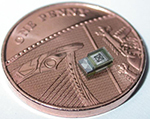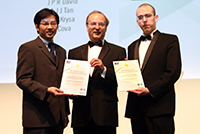Recent News!
January 2010
IeMRC Smart Microsystems Flagship Research Consortium
EPSRC recently awarded the IIS £1.5M to undertake R&D with 14 industrial partners to develop smart microsystems. The formation of this Smart Microsystems cluster is based upon integrating novel materials and processes and provides the UK with the opportunity to create the critical mass to form an agile globally competitive manufacturing capacity to support innovation. This IeMRC Flagship research project will focus on the creation of innovative electronic based systems through integration of microelectronics with novel material and manufacturing technologies. This will involve adapting Micro and Nano Technology(MNT) to integrate electronic ICs with additional components, materials and technologies on single substrates, thereby providing increased device functionality. This IIS Smart Microsystems cluster provides great flexibility in both substrate size (from 200mm wafers down to millimetre scale chips) and substrate material (such as Si, SiC, glass, sapphire and flexible polymers). The resulting microsystems will address a myriad of application areas, including chemical, biological, optical, mechanical, electromagnetic and fluidic technologies.
More details about Smart Microsystem Project can be found from this website: http://imnssm.eng.ed.ac.uk/
December 2009
Two Collaboration Projects in Scottish-China Higher Education Programme
The IIS has been awarded two British Council Collaboration Projects in their Scottish-China Higher Education Programme
1. With Harbin Institute of Technology, China, led by Dr. Richard Fu (with Prof. Anthony Walton, Prof. Gerard Markx and Prof. Marc Desmulliez);
2. With Tsinghua University, China, led by Dr. Will Shu (with Prof. Bob Reuben, Prof. Marc Desmulliez and Prof. Duncan Hand).
November 2009
SELEX Innovation Award to Dr Jason Hong of IIS
The Directors of SELEX Galileo have awarded a Bronze Innovation Award to IIS's Jason Hong. This prestigious prize was given at Sopwell House on November 19th 2009.
November 2009
Shared-Risks Observing Offered On SCUBA-2

SCUBA 2 represents a major innovation from current submillimetre instruments. Incorporating state-of-the-art technology will allow the realisation of the first large-format "CCD-like" camera for submillimetre astronomy. Its development is a collaboration between IIS partners (the UK ATC and the Scottish Microelectronics Centre at the University of Edinburgh), the USA National Institute of Standards and Technology (NIST), the Astronomy Instrumentation Group at the University of Wales at Cardiff, , a consortium of Canadian Universities and the Joint Astronomy Centre (JAC).
SCUBA-2 Shared Risks Observing has been offered as an opportunity for the JCMT community to obtain early science with SCUBA-2 ahead of its full commissioning. It is a chance to demonstrate the potential of the science we can expect to produce with a complete and mature system. The IIS was a major partner in the building of the SCUBA-2 with the SMC involved in the detector fabrication and the UKATC designing and integrating the system as well as project managing the project. More details on the call is available from here.
October 2009
.jpg) HYPOLED, an EC funded project in which IIS is a partner, has received the Excellent Award by the Korean Ministry of Education,
HYPOLED, an EC funded project in which IIS is a partner, has received the Excellent Award by the Korean Ministry of Education,
Science and Technology for its paper and presentation "HYPOLED - VGA OLED microdisplay for HMD and micro-projection" at the 9th International Meeting on Information Displays (IMID'09) in Korea. The Award was received during the IMID banquet on Oct 14. The JRI contribution to the project is developing models for for the OLED materials and is led by Prof Underwood, supported by Gerard Cummins.
Uwe Vogel, the project coordinator notes that "This Award has definitely been achieved by all participants (far beyond the authors of this paper)". The Award certificate can be viewed here.
May 2009
.jpg)
.jpg) The biggest space telescope ever, the 3.5m diameter Herschel Telescope, was successfully launched on May 14th and is now well on its way to its orbit around the L2 Lagrangian point over 1.5 million km from the earth. One of its three instruments is the UK-led SPIRE instrument, comprising an imager and spectrometer working at submillimetre wavelengths (between 200 and 700 microns). Imaging at these wavelengths will enable us to understand the formation of cold, dusty and very distant galaxies, star formation buried in dust in our galaxy, and debris disks around nearby stars.
The biggest space telescope ever, the 3.5m diameter Herschel Telescope, was successfully launched on May 14th and is now well on its way to its orbit around the L2 Lagrangian point over 1.5 million km from the earth. One of its three instruments is the UK-led SPIRE instrument, comprising an imager and spectrometer working at submillimetre wavelengths (between 200 and 700 microns). Imaging at these wavelengths will enable us to understand the formation of cold, dusty and very distant galaxies, star formation buried in dust in our galaxy, and debris disks around nearby stars.
The Institute for Integrated Systems (IIS) Joint Research Institute partner the UK Astronomy Technology Centre (UKATC) built the Beam Steering Mechanism (BSM). The SPIRE detectors need to be ‘jiggled’ on the sky to fill in gaps between them, and hence get fully-detailed images. The BSM moves the image in two directions, very precisely. The BSM can also be used to ‘chop’ between an object and blank sky in order to cancel out the thermal background signal, leaving just the signal from the object.
The engineering challenges of the BSM are: the mechanism has to operate at 4K (4 degrees above absolute zero) to ensure that the astronomical signals are not swamped by thermal emission from the optics; it must dissipate very little heat – 4 milliwatts; and survive high levels of vibration at launch – up to 50 times the force of gravity - still at 4K. It is the first cryogenic mechanism built by the UK ATC for operation in space.
The BSM has now been tested in flight – it has survived the launch and is working perfectly.
Mar 2009
Researchers from the IIS JRI have collaborated to design, fabricate and package a micromachined three-axis accelerometer for heart bypass surgery applications. Further details on this MEMS device are available from the IIS website here.

Jan 2009
 Dr Stewart Smith, a University of Edinburgh researcher based at the Scottish Microelectronics Centre (and also of the IIS JRI), recently attended the prestigious annual awards ceremony of the Institution of Engineering and Technology (IET) in London. Along with his colleague, Dr Tong-Boon Tang, they received the IET Nanobiotechnology Premium Award on behalf of their colleagues from Mr Chris Earnshaw, President IET, for a paper published in 2007 entitled "Development of a miniaturised drug delivery system with wireless power transfer and communication".
Dr Stewart Smith, a University of Edinburgh researcher based at the Scottish Microelectronics Centre (and also of the IIS JRI), recently attended the prestigious annual awards ceremony of the Institution of Engineering and Technology (IET) in London. Along with his colleague, Dr Tong-Boon Tang, they received the IET Nanobiotechnology Premium Award on behalf of their colleagues from Mr Chris Earnshaw, President IET, for a paper published in 2007 entitled "Development of a miniaturised drug delivery system with wireless power transfer and communication".
The paper describes the design and fabrication of a silicon based, implantable, drug delivery system which was produced in the clean rooms at the SMC. This work was funded by the Japanese company, Senju Pharmaceuticals and involved collaboration between researchers at the SMC and clinicians based at Edinburgh’s Princess Alexandra Eye Pavilion.
Jan 2009
 Professor Ian Underwood, Head of the Institute of Integrated Micro and Nano Systems at the University of Edinburgh (and also of the IIS JRI) was delighted to be appointed to the Scottish Science Advisory Council (SSAC) in October 2008.
Professor Ian Underwood, Head of the Institute of Integrated Micro and Nano Systems at the University of Edinburgh (and also of the IIS JRI) was delighted to be appointed to the Scottish Science Advisory Council (SSAC) in October 2008.
The SSAC is a select group of nineteen experts who provide independent advice to the Scottish Government on science, engineering and technology, including the wider opportunities arising from them. The SSAC also advises on the impact of new scientific thought and offers recommendations on science strategy, policy and priorities. All of this is channeled through the Chief Scientific Adviser for Scotland and co-Chair of the SSAC, Professor Anne Glover.
Professor Underwood is recognised worldwide as an authority on display and micro display technology in particular. In 1999 he co-founded MicroEmissive Displays (MED) and was recently elected to Fellowship of the Royal Academy of Engineering and the Institute of Physics in 2008.
Professor Underwood, who is based at the Scottish Microelectronics Centre, plans to continue to devote time and effort to knowledge transfer including the commercialisation of new technology, particularly through spin-out and start-up companies.

